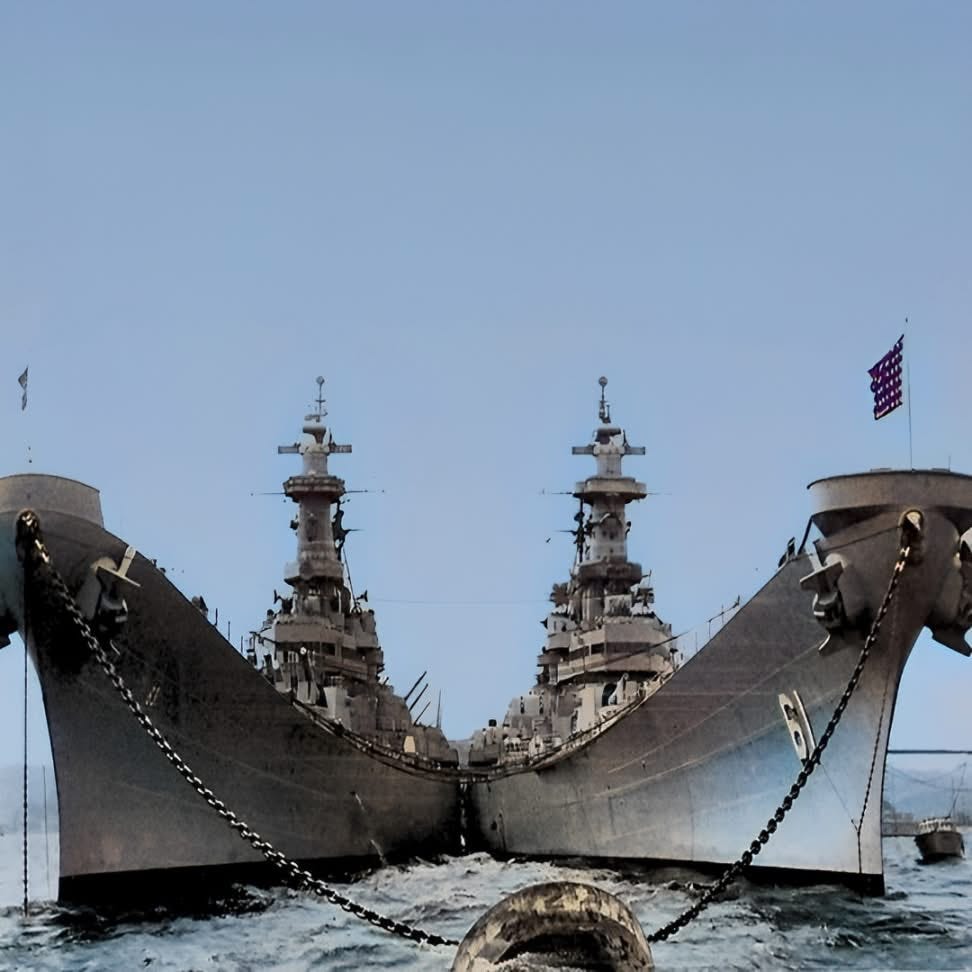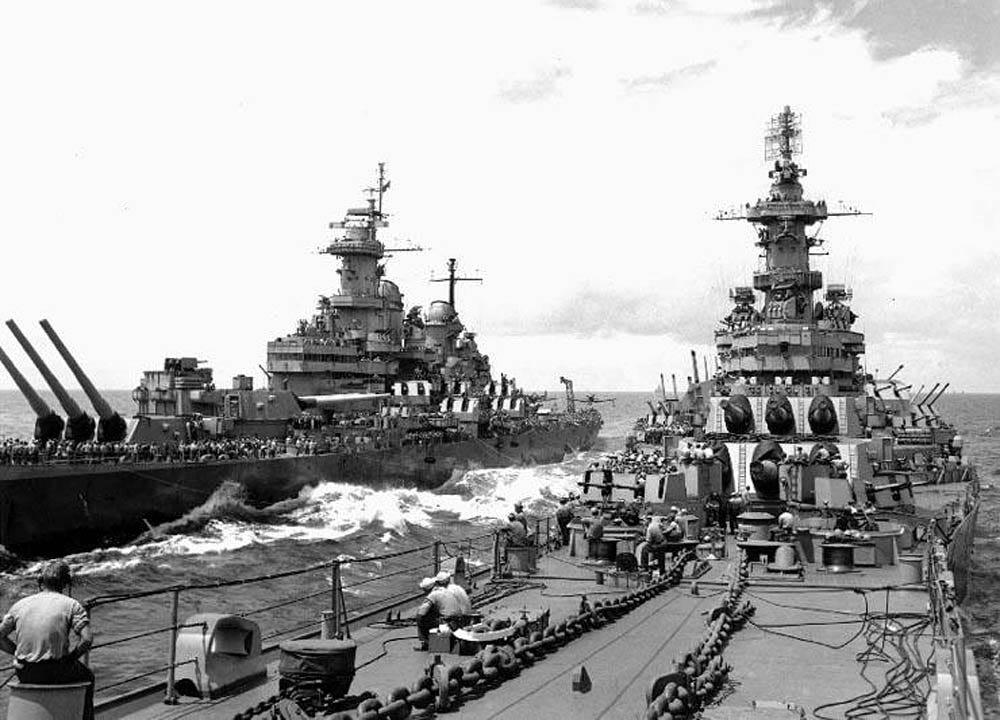Battleships named for Iowa, Missouri made history 80 years ago at end of WWII
The "Mighty I" and "Mighty Mo": made for imposing presence as peace papers signed

WATERLOO — Eighty years ago, on Sept. 2, 1945, the last large heavy battleship commissioned into the U.S. Navy was the stage for the end of World War II.
While the battleship USS Missouri (hull number BB-63) was the location for the Allied powers and the Empire of Japan to sign the “instrument of surrender,” ending the war, its sister ship, the USS Iowa, played a supporting role.
The two ships were part of the group of “Iowa class” battleships built during the war — so named because the Iowa was the first ship of the class built and commissioned into the Navy. The others were the USS New Jersey (BB-62) and the USS Wisconsin (BB-64).
The USS Iowa, nicknamed the “Mighty I” at the time and commissioned into service in February 1943, earned nine battle stars for its World War II service — one battle star for each of the engagements in which it was involved. It would later earn two additional battle stars for Korean War service, during which it became known as “The Gray Ghost.”
The Missouri, known as “Mighty Mo” or “Big Mo,” was commissioned into service and entered the Pacific theatre of operation almost two years later, in January 1945. But it earned three battle stars for its service including participation the crucial battles for the islands of Iwo Jima and Okinawa. Both the Missouri and Iowa participated in the battles of Leyte Gulf and Okinawa.
The Iowa suffered its most serious damage of the war not in combat, but in a storm. One of its propeller shafts was bent in Typhoon Cobra in December 1944 in which three destroyers were sunk and 790 sailors lost their lives. The Iowa went to San Francisco for repairs and was back in theater in March 1945.
Both the Iowa and the Missouri had shelled military positions on the Japanese home islands prior to the empire’s Aug. 14, 1945 surrender following the dropping of atomic bomb on Hiroshima Aug. 6 and Nagasaki Aug. 9
Both steamed toward Tokyo Bay to begin the demilitarization and occupation of Japan. A landing party of some 200 troops was transferred from the Missouri to the Iowa to begin that process on Aug. 21.

Shortly thereafter it was announced that the Missouri, as the flagship of the U.S. Third Fleet and Admiral William “Bull” Halsey, would be the site of the formal Japanese surrender Sept. 2. The Missouri also happened to be the namesake of the home state of President Harry S. Truman and his daughter Margaret was the ship’s official Navy sponsor.
A number of Navy personnel had to be transferred from the Missouri to the Iowa to make room for the dignitaries and military commanders of the various combatant nations and their delegations for the official signing of the peace documents. The Iowa remained in Tokyo Bay during the ceremony as a show of force, among a large flotilla of Allied ships, including some American vessels which had survived the Japanese attack on Pearl Harbor 3 1/2 years earlier, as well as British Royal Navy vessels which has sunk Nazi battleship in the war in the Atlantic.

In addition to their service in World War II and Korea, the latter of which earned the Missouri another five battle stars, both the Iowa and the Missouri were recommissioned into service in the 1980s as part of President Reagan’s military buildup which included a 600-ship Navy. The Iowa served in the Persian Gulf before being decommissioned in 1990, and the Missouri participated in the 1991 Persian Gulf War before being decommissioned in 1992.
Both vessels are now museum ships. The “Might Mo” is part of the Battleship Missouri Memorial at Pearl Harbor in Hawaii. It is docked at Ford Island on the location on “Battleship Row” where the battleship USS Oklahoma capsized in the attack on Pearl Harbor, killing 429 sailors including many Iowans and the first American military chaplain killed in World War II, Roman Catholic Rev. Aloysious Schmitt of St. Lucas in Fayette County.
The USS Iowa, or the Battleship Iowa Museum, is located at the Port of Los Angeles in San Pedro Calif. not far from another attraction, the famous British ocean liner RMS Queen Mary, at Long Beach.

The state of Iowa paid $3 million toward the USS Iowa’s preservation before it was opened for public tours in 2012. Visiting Iowans may tour “The Gray Ghost” for free by simply displaying an Iowa driver license or state identification. There is an ongoing deck and hull preservation project for the ship. To learn more about and donate to that project, click here
The Sullivan Brothers Iowa Veterans Museum, part of the Grout Museum District in Waterloo, has a permanent exhibit on the BB-61, and is putting one together on its predecessor, the USS Iowa BB-4, which served in the Spanish-American War. A successor vessel to the BB-61, the USS Iowa submarine SSN-797, was commissioned into Navy service earlier this year.
Pat Kinney is a freelance writer and former longtime news staffer with the Waterloo-Cedar Falls Courier and, prior to that, several years at the Ames Tribune. He is currently an oral historian with the Grout Museum District in Waterloo. His “View from the Cedar Valley” column is part of “Iowa Writers Collaborative,” a collection of news and opinion writers from around the state who previously and currently work with a host of Iowa newspapers, news organizations and other publications. They are listed here. Clink on their individual links to check them out, subscribe for free - and, if you believe in the value of quality journalism, support this column and/or any of theirs with a paid subscription. Thank you.


I watched with Mary C. referred to. I think this is the url. https://www.pbs.org/show/surrender-uss-missouri/
I did notice several documentaries on this.
I agree with the threats to our democracy from attacks on all media, including PBS. Tomorrow, I am meeting with a development officer of Iowa PBS to help them out.
PS. My dad and four of his brothers all served at the same time in WWII. They all came back; they never talked about what they experienced--except for oddly humorous events.
I recently watched an excellent program on the USS Ipwa. An Iowa PBS program. The vessel's history, accident, restoration, crew, reunions. and current location and use were highlights. This type of programming will be lost due to the action of Iowa Congressional reps. Ernst said PBS spews propaganda.